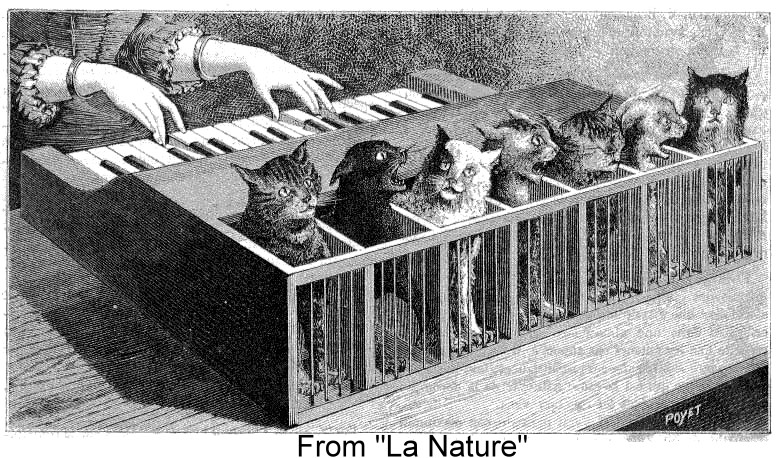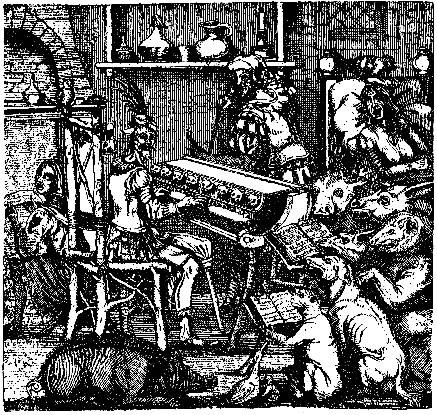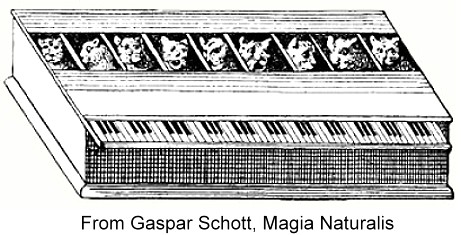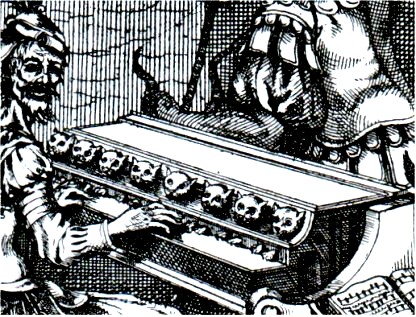
THE KATZENKLAVIER (CAT PIANO or CAT ORGAN)
The Cat Organ or Cat Piano (Katzenklavier) was an alleged musical instrument comprising a line of seven to nine cats held in place with their tails stretched out underneath a keyboard. When a key was pressed, the tail underneath was either pulled, struck or spiked, and the corresponding cat cried out in pain. The cats would be arranged according to the natural tone of their voices allowing tunes to be played. There are no records of a genuine Cat Organ actually being built, however the story has been re-reported several times since the 1550s.

French writer and composer Jean-Baptiste Weckerlin (1821-1910) described a Cat Organ wrote in "Musiciana, extraits d’ouvrages rare ou bizarre" (Musiciana, descriptions of rare or bizarre inventions). He attributed a description of it to Juan Christoval Calvete, a historian accompanying the King of Spain in 1549. In 1552, Calvete described the festivities in Italy and the Netherlands during Prince Philip's journey in 1548-49. Calvete's accounts were widely circulated at the time and became part of Spanish Renaissance festival culture. The festivals were based on Roman triumphal processions with other classical allusions, appropriated by the advisors of Emperor, and king of Spain, Charles V to celebrate his rule. Weckerlin wrote:
"When the King of Spain Felipe II was in Brussels in 1549 visiting his father the Emperor Charles V, each saw the other rejoicing at the sight of a completely singular procession. At the head marched an enormous bull whose horns were burning, between which there was also a small devil. Behind the bull a young boy sewn into a bear skin ride on a horse whose ears and tail were cut off. Then came the archangel Saint Michael in bright clothing, and carrying a balance in his hand.
The most curious was on a chariot that carried the most singular music that can be imagined. It held a bear that played the organ; instead of pipes, there were sixteen cat heads each with its body confined; the tails were sticking out and were held to be played as the strings on a piano, if a key was pressed on the keyboard, the corresponding tail would be pulled hard, and it would produce each time a lamentable meow. The historian Juan Christoval Calvete, noted the cats were arranged properly to produce a succession of notes from the octave... (chromatically, I think). This abominable orchestra arranged itself inside a theatre where monkeys, wolves, deer and other animals danced to the sounds of this infernal music."

While pulling a caged cat's tail is cruel, the version of instrument described by German Jesuit scholar Athanasius Kircher (1602–80) Musurgia Universalis (1650) was worse, though there is no evidence he built such an instrument. Contrary to popular belief, Kircher wasn't the inventor of the katzenklavier; he was an uncritical collector of information from numerous sources and his account makes it clear that he is reporting what he has been told by other parties. Kircher wrote:
"In order to raise the spirits of an Italian prince burdened by the cares of his position, a musician created for him a cat piano. The musician selected cats whose natural voices were at different pitches and arranged them in cages side by side, so that when a key on the piano was depressed, a mechanism drove a sharp spike into the appropriate cat's tail. The result was a melody of meows that became more vigorous as the cats became more desperate. Who could not help but laugh at such music? Thus was the prince raised from his melancholy."
There was also said to have been a fairground attraction called "Miaulique" in Saint-Germain during the 17th century. Jacques-Christophe Valmont de Bomare (1731-1807) described a "Miaulique" booth at the Fair of Saint-Germain. Inside the booth, some cats sat on a table before a piece of music and at a signal given by a monkey they played feline melodies and harmonies. In fact there were a number of operas and performances around Europe that involved trained feline performers conducted by monkeys.
Despite that era being the Age of Reason, cats were still subjected to persecution, while animal baiting sports were also commonplace. Weckerlin claimed that records had been found indicating the existence of the Katzenklavier at Saint-Germain in 1753 and at Prague in 1773. Despite these accounts, the Katzenklavier appears to have been a hypothetical musical instrument, although there were 17th-century posters that implied that mountebanks gave Cat Piano concerts at fairs. The public, with its lust for cruelty in the form of animal baiting, would have found the prospect attractive.

The Cat Piano was described in 1803 by German physician Johann Christian Reil (1759–1813) for the purpose of treating patients who had lost the ability to focus their attention on external objects and were in a state of constant reverie (daydream). Reil believed that if they were forced to see and listen to this instrument, it would inevitably capture their attention and they would be cured. Reil's description suggests that the patient would be roused from reverie through upset, rather than amusement. Was it coincidence, or did Reil choose the term "fugue" as a pun? Reil was treating mental disorders and a fugue is a type of amnesiac episode as well as a type of musical composition.
Reil wrote in "Rhapsodieen über die Anwendung der psychishen Curmethode auf Geisteszerrüttungen" (1803) An octave's worth of cats arranged in a row with their tails stretched behind them. And a keyboard fitted out with sharpened nails would be set over them. The struck cats would provide the sound. A fugue played on this instrument - when the ill person is so placed that he cannot miss the expression on their faces and the play of these animals - must bring Lot's wife herself from her fixed state into conscious awareness.”
In fact, as Champfleury noted in 1870, cats do not meow or scream in a fixed pitch, which would make the playing of recognisable tunes impossible. Nor would they mew or cry in a consistent pitch. Modern musicians can sampling to record cats meowing, adjust the pitch, and create a Cat Synthesiser. Champfleury found an old picture of a Cat Organ in Gaspard Schott's "Magia Universalis" (1657) which he reproduced in his own publication, "Les Chats". Champfleury also reproduced an 18th Century woodcut showing an animal tamer with cats playing various string instruments and singing "miaou". The poster is titled "Le Musique de Chats".
In his book "The Tiger in the House" (1936) Carl Van Vechten (1880-1964), who compiled information from a number of earlier sources mentioned here, believed Cat Organs to have been relatively common in the 16th and 17th Centuries, and even into the 18th Century.
An amusing and completely humane version of Cat Piano was created by Henry Dagg using squeaky furry toy cats; these were squeezed to play tunes, much as a rack of differently sized rubber-bulbed car horns can been played as instruments. This instrument was played for Prince Charles at a garden party held at Clarence House in 2010. The tune "Over the Rainbow" played on squeaky toys apparently caused much amusement.
The People's Republic Of Animation released a short animated film called The Cat Piano. This told the tale of a city of cats whose musicians are kidnapped by a human in order to make a Cat Piano. The main character explained that the Cat Piano was an instrument, much like any ordinary piano or harpsichord, but instead of using strings and hammers to play notes, the Cat Piano produced noise by striking a nail into the tails of one or more cats that are caged in the piano, making them scream in pain.
References